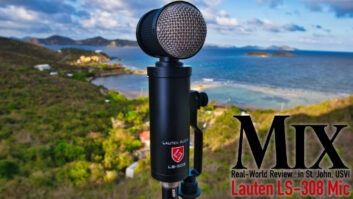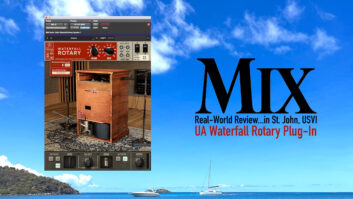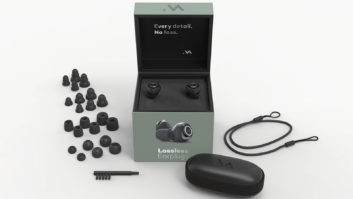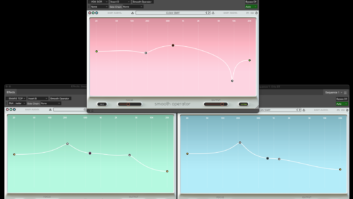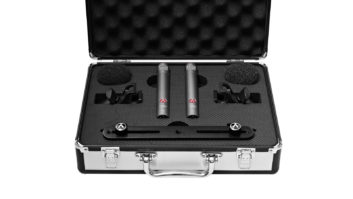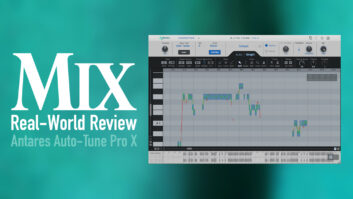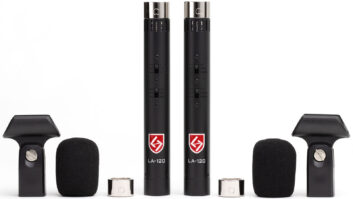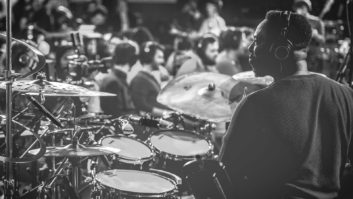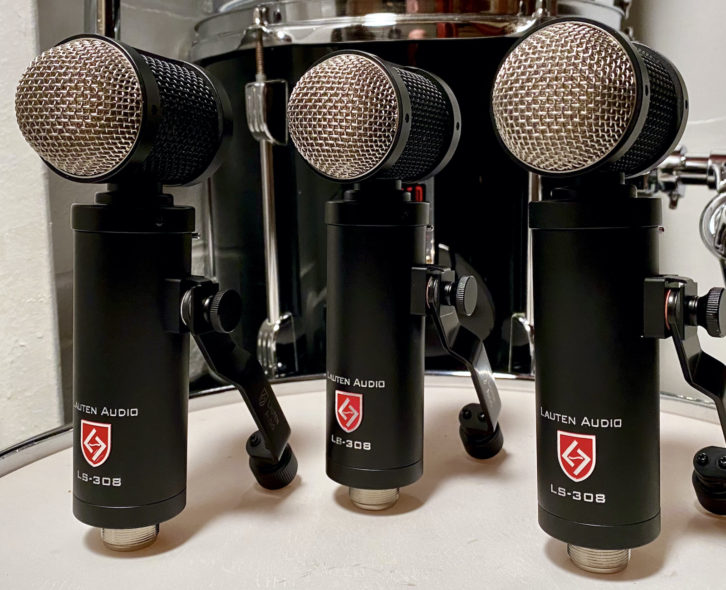
Getting great tom tom sounds can be pretty tricky. There’s seldom room for large mics while typically loud cymbals are within inches, creating problematic bleed. You can also throw in the fact that getting consistency from drum-to-drum requires careful tuning and technique from both drummer and mic, and that the tone from a 16th note rapid fill is quite different from a whole-note power-slam.
In the face of all that, I find myself wanting condenser mic attack (but without the harsh off-axis bleed), dynamic mic punch (but with more detail) and ribbon mic nulls (but without a figure-8 pattern or fragility). The Lauten Audio LS-308 appears to have all but solved these problems.
Lauten’s new Synergy Series (which includes the LS-208) offers condenser mic performance in highly directional and rugged designs that can function in loud and difficult environs where dynamics would typically be the norm— concert stages or live studio recordings—especially on drum kits.
Lauten achieves this with a dual-capsule design which spaces the two diaphragms one inch apart (and surely manipulates the backplate venting, membrane tension and phase) to achieve a tight second order cardioid pattern with only 90 degrees of sensitivity, 270 degrees of rejection and up to -25 dB attenuation of off-axis sources.
The LS-308 is a side-address, pressure-gradient, large-diaphragm condenser with a FET amplifier and custom output transformer. The 32mm capsules (and accompanying electronics) can handle a loud 135 dB without any pad. Frequency response is essentially flat between 50 Hz and 5 kHz, with a rolloff above that. The bottom- and top-end response is tailor-able with a pair of bypassable filters—a highpass selectable at 50 or 120 Hz and a lowpass at 8 or 10 kHz. The 308 is supplied as a complete kit with a padded flight case, foam windscreen, a threaded-ring stand adaptor (“Lauten” is German for “ring,” after all), and a side-mounted, yoke-swivel arm.
ALL AROUND THE KIT
A brief test on my vocals reinforced that the 308 is indeed a “special ops” mic, not at all balanced like a typical bright condenser but instead thickly dark with subdued mids and top. The build quality, fit and finish are excellent, with a “hammerhead” body/basket, firm switches and mounts that hold steady.
On my studio’s house drum kit with large Ludwig toms and thick, coated heads (amplified with True Precision 8 preamps, my favorites for big rock toms), I placed three 308s on two racks and a floor. They sat about three inches above the rims, angled down— about where I’d typically place Sennheiser 421s when there’s room, with a little less gain than 421s.
The result was a big, thick, punchy sound; the top end seemed slightly muted at first, but there was ample attack and detail. The cymbal bleed was notably lower than normal, too. When bringing up all three tom mics at once, the bleed usually got irritating around -6 dB, but it wasn’t until I pushed them up to unity gain with toms well represented in the mix that cymbal noise began to bother me.
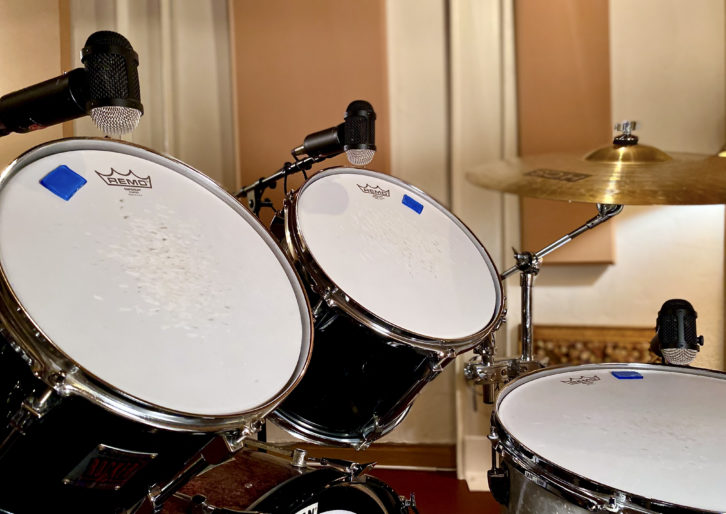
Next, I tried the 50 Hz HPFs and the response was ideal, nice and full without tubbiness or mud. The 125 Hz filters clarified the bass, and the resulting tone was only slightly thin. For those of you who like to get that mic really close to the drum (for the proximity effect and the isolation, as often done in aggressive genres and live sound), you’ll likely find the HPFs indispensable—or you might find yourself able to pull back a little bit for more shell tone.
On a different kit with smaller toms and thinner, clear heads, I was able to position the 308s much closer, but I still used the 50 Hz filters.
Hoping that a 308 might solve the ol’ “hi-hat bleed in the snare” problem, I gave it a try, only to find a tone that needed more top-end and midrange definition, although it paired nicely with a Shure SM57 filling in the missing mids/top. [Lauten advises that the LS-208 would fit this application nicely.]
Placed on the bottom of the snare, with a polarity flip and the 50 Hz HPF engaged, the 308 worked well, providing plenty of thump, understated snare wires and very little kick bleed. I tried a 308 outside of a kick drum (no HPF) and got useful results there, too, with deep bass extension and virtually no cymbal bleed.
CHECKING OUT GUITAR
On an electric guitar amp, the 308s performed predictably. Without filters, the tone was quite thick—near perfect with a 50 Hz filter and just a little shallow at 120. I found myself adding considerable top end for a balanced tone, but when paired with a Shure SM57, the 308 filled in the missing depth and mitigated the aggressive high-mids of the 57; it was very much like pairing a ribbon with a 57, but with more note-definition/clarity way down low.
I tried the LPFs and again found them unnecessary. For what it’s worth, I never did find a real need for the LPFs, although I’m sure their day will come.
Sennheiser MD 445 / MD 435 Mics – A Real-World Review
Bass guitar and 308s go together perfectly. The mic handles the SPL of a loud amp no problem, and the tone is dialed-in and mix ready. To get a sound super-punchy but just a little dark, you’ll need to sweeten up the highs for a thumb-popping or crispy tone, or perhaps kick in a HPF if the subs get out of hand.
Unfortunately, I did not get to try the 308s on a live stage (where drum, bass and guitar amps would be natural), as COVID restrictions are just ending here, and our local stages are not quite back in business. Nonetheless, that got me thinking about where else a highly-directional thick-sounding, tough, SPL-munching condenser might be useful—perhaps some louder Foley work, sporting events, shoulder-to-shoulder horn sections (live or in-studio), percussion kits or maybe even Leslie cabinet woofers.
THE FINAL MIX
Despite hard-to-believe claims, the LS-308 delivers as promised, with high-SPL handling, incredible off-axis rejection, extended bottom end, a smooth and understated top-end, mild compression of dynamics, versatile lowpass filtering, and absolutely crucial highpass filtering that allows numerous placement options. The 308’s case, mounts and windscreen find it ready for live sound and the rigors of touring.
Priced at $499, the LS-308 seems expensive for a “tom tom mic,” but it’s actually underpriced considering the versatility, uniqueness and depth of its numerous problem-solving abilities. Kudos to Brian Loudenslager and the Lauten team for tackling long-standing issues in the analog realm with innovations that make my difficult work a little easier.
